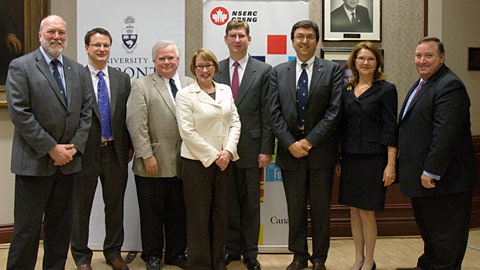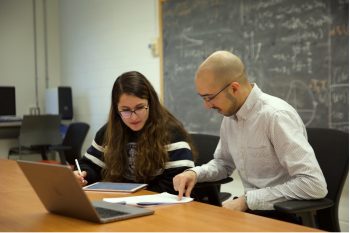
TORONTO, ON – With infrastructure spending a big part of government economic stimulus plans across North America, concrete is suddenly looking like a hot commodity. The University of Toronto’s Faculty of Applied Science and Engineering is at the forefront of innovation when it comes to concrete, sustainability and engineering solutions to some of the world’s most pressing issues. Now, one of our top professors has received recognition from the industry and the federal government.
R. Doug Hooton was appointed today Chairholder of the Natural Sciences and Engineering Research Council (NSERC) of Canada/ Cement Association of Canada Industrial Research Chair in Concrete Durability and Sustainability.
“Industrial Research Chairholders have to be outstanding researchers, able to build and nurture successful relationships with their industrial partners,” says Suzanne Fortier, president of NSERC. “Dr. Hooton is an excellent example of this blend of talent and skills. The Canadian cement and concrete industries will benefit greatly from his research goal to produce stronger, higher quality building materials.”
The Chair’s funding is valued at $1.8 million over five years with contributions from the University of Toronto, NSERC, the Cement Association of Canada, Holcim Canada and Whitemud Resources. The financial award will create a new tenure-track faculty position in this area and also allow for funding graduate student and research associate positions.
The goal of the Research Chair is to provide innovative and effective approaches to improve both the environmental sustainability and durability of concrete, as well as to provide leadership in development of specifications and industry standards. Enhancing the durability of concrete, while incorporating recycled local materials, improves the sustainability of buildings and infrastructure.
“This Chair will help focus research and teaching in an area that is critical to making informed choices in infrastructure renewal and addressing the environmental and energy sustainability challenges facing the cement, concrete and construction industries,” said Dr. Hooton. “This area is of utmost importance to the Canadian cement industry and to Canadian industry and infrastructure as a whole, and I want to thank NSERC and the industrial partners for their commitment, even in tough economic times.”

Some of Professor Hooton’s discoveries in the chemical degradation of concrete by alkali-silica reaction and in the rate of penetration of de-icing salts leading to corrosion of steel in concrete bridges have been adopted by the Ontario Ministry of Transportation as well as in Canadian (CSA) and US (ASTM) standards. He is also using sophisticated nanotechnology level tools to examine the chemistry and mineralogy of concrete and to investigate its durability. He also hopes to use ‘particle packing’ down to the nano level to make what he calls “quantum leaps” in the properties and durability of concrete.
“Professor Hooton is a leading innovator in the important field of sustainable concrete engineering and cement research,” said Cristina Amon, Dean, Faculty of Applied Science and Engineering. “We are grateful to NSERC and our industrial partners for enhancing our efforts to address concrete sustainability and its environmental implications in the infrastructure renewal.”
Readers may also be interested in a recent article published on May 11, 2010 in the Daily Commercial News and Construction Record titled, University of Toronto professor awarded concrete-research chair.



